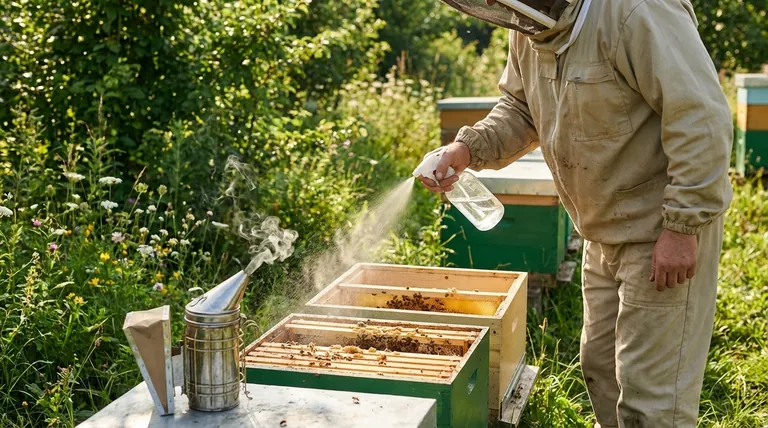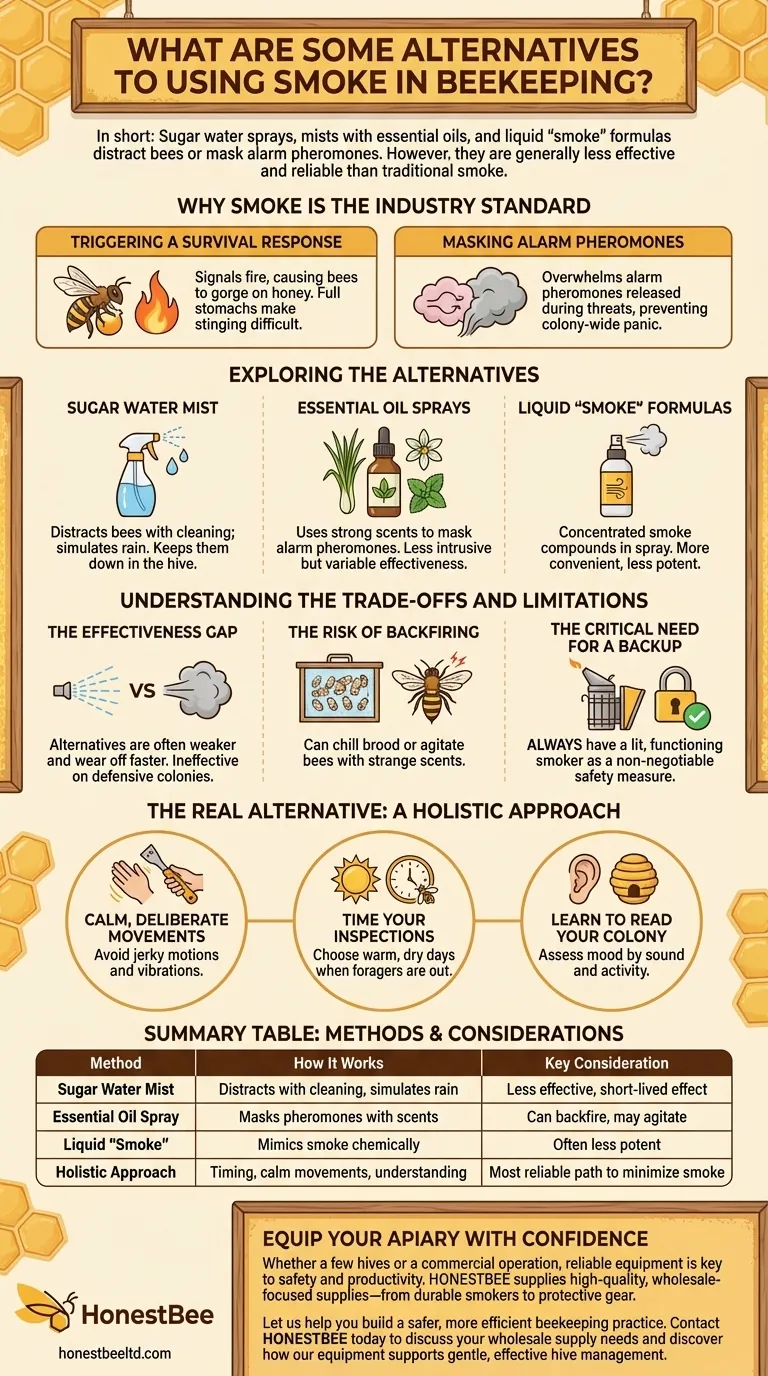In short, the most common alternatives to using smoke in beekeeping are sugar water sprays, mists with essential oils, and specialized liquid "smoke" formulas. These methods aim to distract the bees or mask alarm pheromones, but they are generally considered less effective and reliable than traditional smoke.
While replacing a smoker is an appealing idea, the most effective approach isn't finding a one-to-one substitute. True gentle beekeeping relies on a holistic strategy that combines timing, calm movements, and an understanding of bee behavior, often using minimal smoke as a tool rather than eliminating it entirely.

Why Smoke is the Industry Standard
To understand the alternatives, you must first understand why smoke is so effective. It isn't just a random irritant; it leverages the bees' deep-seated survival instincts in two specific ways.
Triggering a Survival Response
Smoke signals the possibility of a nearby fire, which is a major threat to a honey bee colony. In response, bees begin to gorge on honey in preparation to potentially abandon the hive. Bees with full stomachs are physically less able to flex their abdomens to sting and are generally more docile.
Masking Alarm Pheromones
When a bee stings or feels threatened, it releases alarm pheromones. These chemical signals alert other bees in the colony to a danger, triggering a defensive chain reaction. The strong scent of smoke effectively overwhelms and masks these pheromones, preventing widespread panic and keeping the colony calm.
Exploring the Alternatives
For beekeepers who wish to avoid smoke, several methods have been developed. However, their effectiveness can vary dramatically depending on the colony's temperament and environmental conditions.
Sugar Water or Plain Water Mist
Spraying a light mist of 1:1 sugar water (or even plain water) over the frames is the most common smoke-free technique. This distracts the bees, as they will stop to clean the sticky liquid off themselves and their hive mates. It can also simulate rain, encouraging them to stay down in the hive rather than flying up at you.
Essential Oil Sprays
Some beekeepers add a few drops of essential oils, such as lemongrass or spearmint, to their water spray. The theory is that these strong, pleasant scents can help mask the bees' alarm pheromones, similar to how smoke does, but in a less intrusive way.
Liquid "Smoke" Formulas
Commercially available products, often called "liquid smoke," are essentially concentrated smoke compounds in a spray bottle. These mimic the chemical effects of smoke without the need for a lit smoker, offering a more convenient but often less potent alternative.
Understanding the Trade-offs and Limitations
While the idea of a smokeless inspection is attractive, it is critical to recognize the limitations of these alternative methods. Their failure can turn a calm inspection into a dangerous one.
The Effectiveness Gap
No alternative is as consistently effective as smoke. A water spray that works perfectly on a calm, docile hive may do nothing to quell a more defensive colony. The effect is often weaker and wears off much faster than that of smoke.
The Risk of Backfiring
Improperly used alternatives can make the situation worse. A spray that is too heavy can chill the sensitive brood, and some colonies may perceive a strange essential oil scent as a threat, increasing their agitation instead of calming it.
The Critical Need for a Backup
Because of their unreliability, it is a widely accepted best practice to always have a lit and functioning smoker on hand, even if you plan to use an alternative method. If a hive suddenly becomes aggressive, you need a reliable tool to calm the bees and safely close up the hive. This is a non-negotiable safety measure.
The Real Alternative: A Holistic Approach
Ultimately, minimizing hive disruption goes beyond simply swapping one tool for another. The true path to "smokeless" or "less-smoke" beekeeping is about your overall approach.
Practice Calm, Deliberate Movements
Bees perceive quick, jerky motions and vibrations as threats. Every movement you make should be slow, gentle, and deliberate. Avoid bumping the hive or dropping tools. Your calm demeanor is one of the most effective tools you have.
Time Your Inspections Carefully
Choose the right time to open a hive. The ideal conditions are a warm, dry, sunny afternoon when the majority of the hive's foragers are out collecting nectar and pollen. Avoid inspections on cool, windy, or rainy days when the hive is full of defensive bees.
Learn to Read Your Colony
Experienced beekeepers can assess a colony's mood just by the sound and activity at the entrance. If the bees seem agitated before you even open the hive, the wisest decision is often to postpone the inspection for another day.
How to Apply This to Your Beekeeping
Your choice of method should align directly with your goals and experience level.
- If your primary focus is maximum safety and reliability: Use a smoker. It is the most proven and effective tool for keeping both you and your bees safe during inspections.
- If your primary focus is experimenting with a known docile hive: You can try a 1:1 sugar water spray on a perfect day, but keep a lit smoker within arm's reach as an essential backup.
- If your primary focus is bee-centric, low-stress management: Combine a holistic approach of proper timing and gentle movement with the judicious use of smoke, applying only a few small puffs when absolutely necessary.
True gentle beekeeping is achieved through empathy and understanding of bee behavior, not simply by the absence of a single tool.
Summary Table:
| Method | How It Works | Key Consideration |
|---|---|---|
| Sugar Water Mist | Distracts bees with cleaning; simulates rain. | Less effective on defensive colonies; effect is short-lived. |
| Essential Oil Spray | Masks alarm pheromones with strong scents. | Can backfire; some scents may agitate bees. |
| Liquid 'Smoke' | Mimics smoke's chemical effects via a spray. | Often less potent than traditional smoke. |
| Holistic Approach | Combines timing, calm movements, and bee behavior understanding. | The most reliable path to minimizing smoke use. |
Equip Your Apiary with Confidence
Whether you manage a few hives or a large commercial operation, having the right, reliable equipment is the foundation of safe and productive beekeeping. HONESTBEE supplies commercial apiaries and beekeeping equipment distributors with high-quality, wholesale-focused supplies—from durable smokers to essential protective gear.
Let us help you build a safer, more efficient beekeeping practice.
Contact HONESTBEE today to discuss your wholesale supply needs and discover how our equipment supports gentle, effective hive management.
Visual Guide

Related Products
- Economy Galvanized Beekeeping Honey Bee Smoker for Wholesale
- Premium Traditional Copper Bee Smoker with Bellows
- Stainless Steel Honey Bee Smoker Hive and Honeycomb Smoker for Beekeeping
- Professional Bee Smoker with Elongated Spout and Durable Bellows for Beekeeping
- European Stainless Steel Bee Smoker for Honey Bee Hive
People Also Ask
- What is the purpose of a bee smoker? Calm Bees for Safer, More Efficient Hive Inspections
- What is a bee smoker and what is its primary purpose? Master Safe Hive Inspections
- What are the common design features of a bee smoker? Choose the Right Smoker for Your Apiary
- What type of smoke is needed to calm honey bees? Use Cool, White Smoke for a Safe Hive Inspection
- What is a Smoker and how is it used in beekeeping? The Essential Tool for Calm, Safe Hive Inspections



















